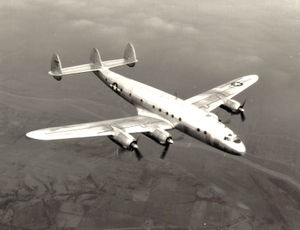
Back لوكهيد كونستليشن Arabic Lockheed Constellation Byelorussian Lockheed Constellation Czech Lockheed Constellation Danish Lockheed Constellation German Lockheed Constellation Spanish لاکهید کونستلیشن Persian Lockheed Constellation Finnish Lockheed Constellation French Lockheed Constellation Frisian
| Constellation | |
|---|---|
 A USAF C-69, the military version of the Constellation | |
| General information | |
| Type | Airliner and transport |
| Manufacturer | Lockheed |
| Status | In very limited service |
| Number built | 856 |
| History | |
| Manufactured | 1943–1958 |
| Introduction date | 1943 with USAAF 1945 with TWA |
| First flight | January 9, 1943 |
| Retired | 1990s, airline service 1978, military |
| Developed from | L-044 Excalibur |
| Variants | L-049 Constellation C-69 Constellation L-649 Constellation L-749 Constellation L-1049 Super Constellation C-121/R7V Constellation R7V-2/YC-121F Constellation EC-121 Warning Star L-1649A Starliner |
| Developed into | Lockheed XB-30 (Unbuilt) |
The Lockheed Constellation ("Connie") is a propeller-driven, four-engined airliner built by Lockheed Corporation starting in 1943. The Constellation series was the first civil airliner family to enter widespread use equipped with a pressurized cabin, enabling it to fly well above most bad weather, thus significantly improving the general safety and ease of commercial passenger air travel.[1]
Several different models of the Constellation series were produced, although they all featured the distinctive triple-tail and dolphin-shaped fuselage. Most were powered by four 18-cylinder Wright R-3350 Duplex-Cyclones. In total, 856 were produced between 1943 and 1958 at Lockheed's plant in Burbank, California, and used as both a civil airliner and as a military and civilian cargo transport. Among their famous uses was during the Berlin and the Biafran airlifts. Three served as the presidential aircraft for Dwight D. Eisenhower, one of which is at the National Museum of the United States Air Force.
- ^ Historic airliner trucked 300 miles to be a hotel bar CNN Travel. By Thom Patterson. 13 October 2018. Downloaded Oct. 21, 2018.